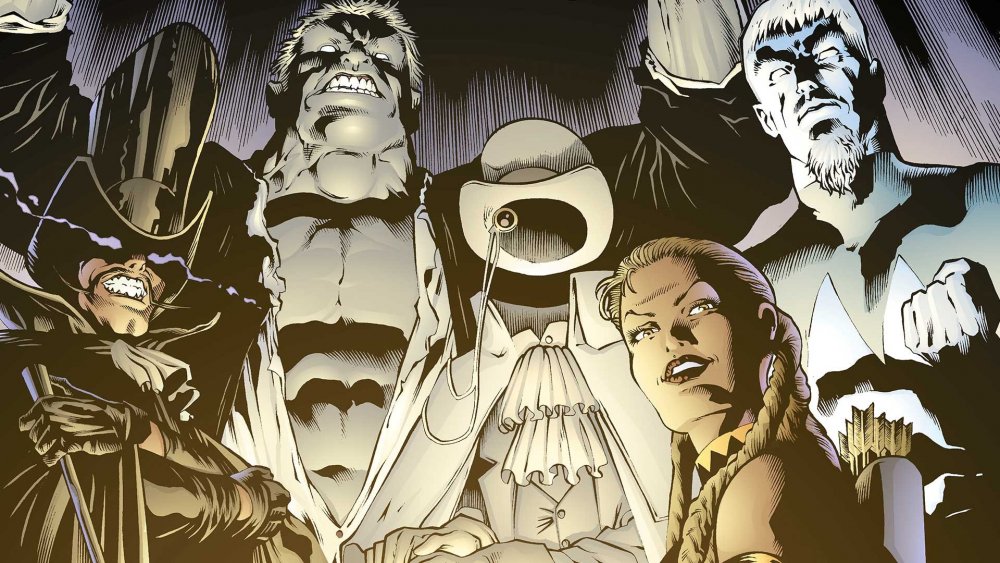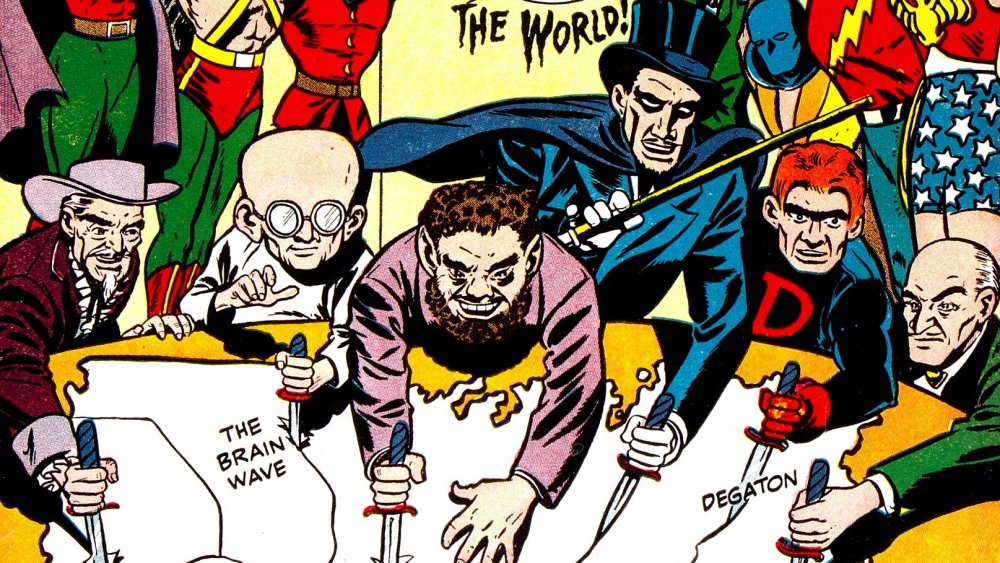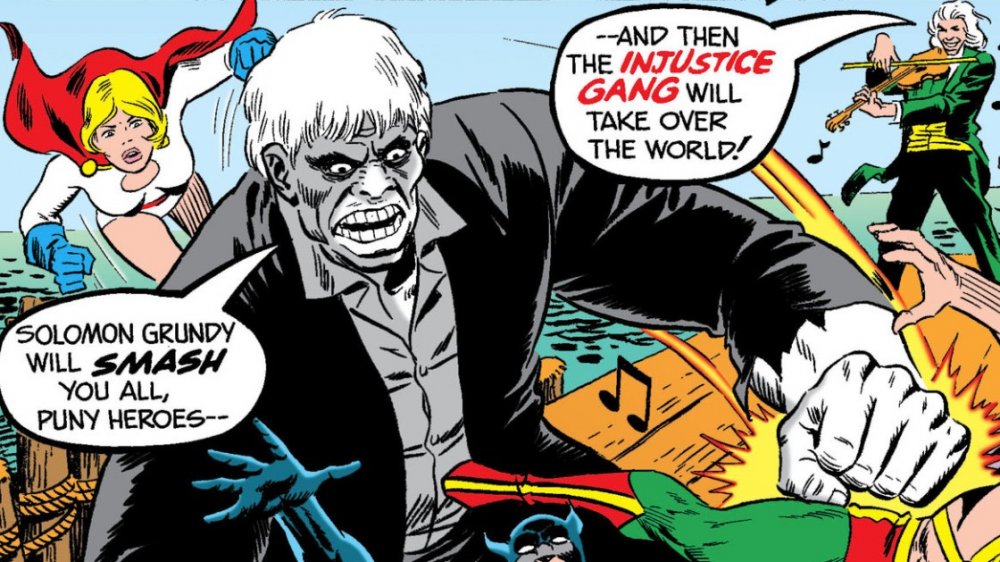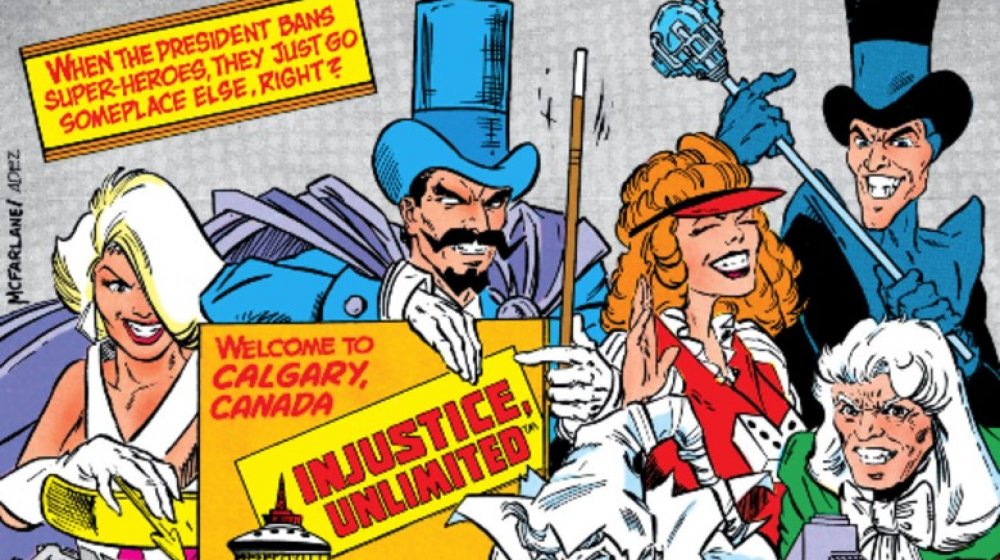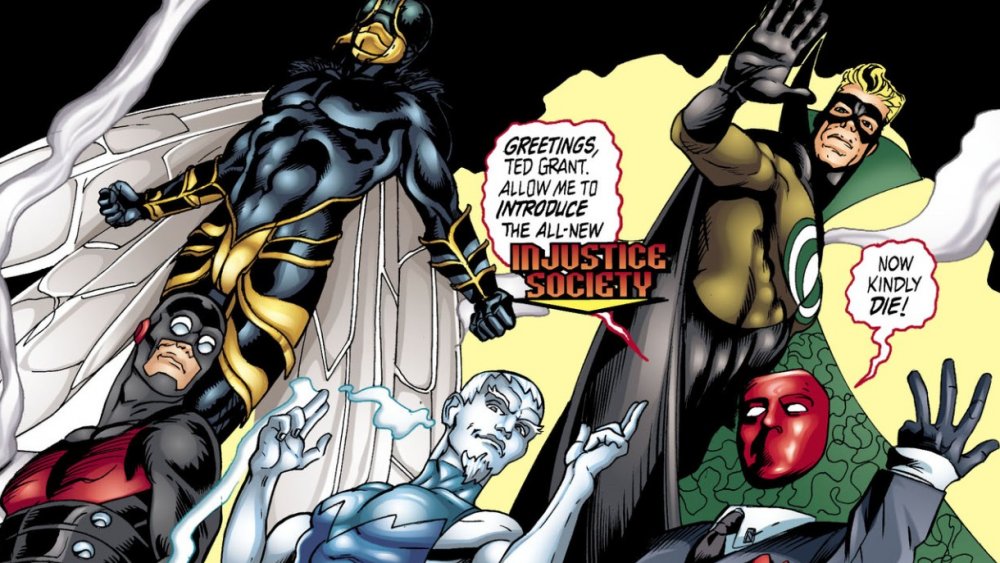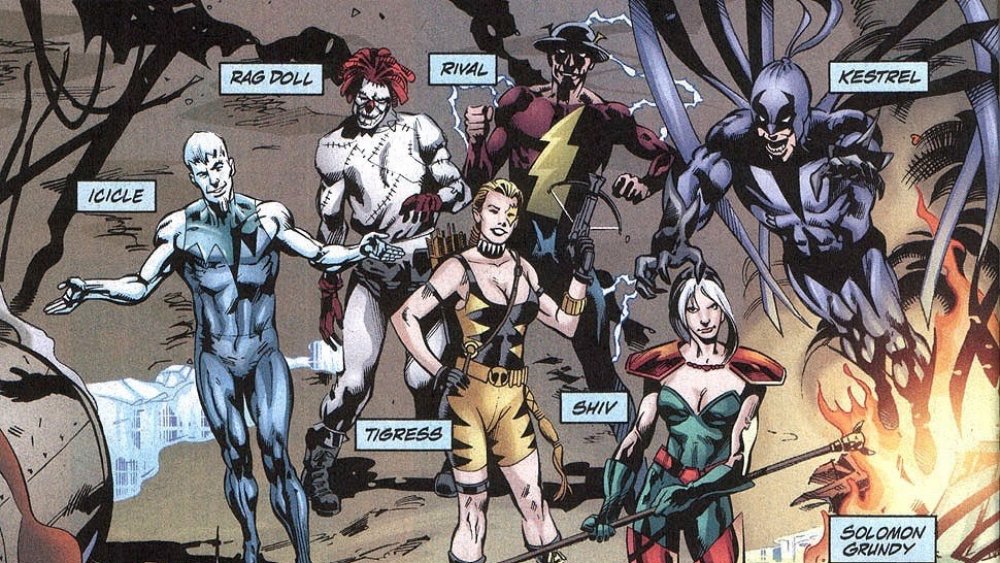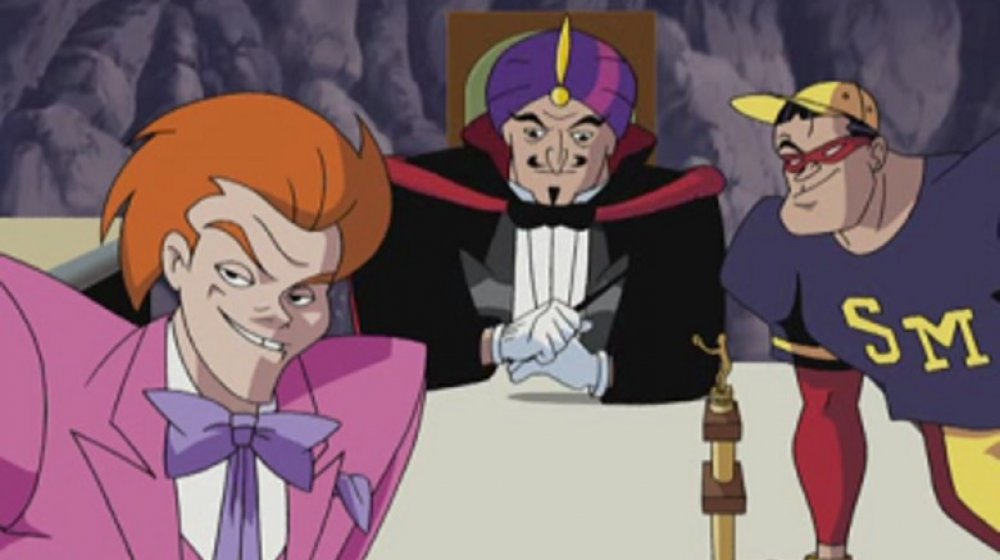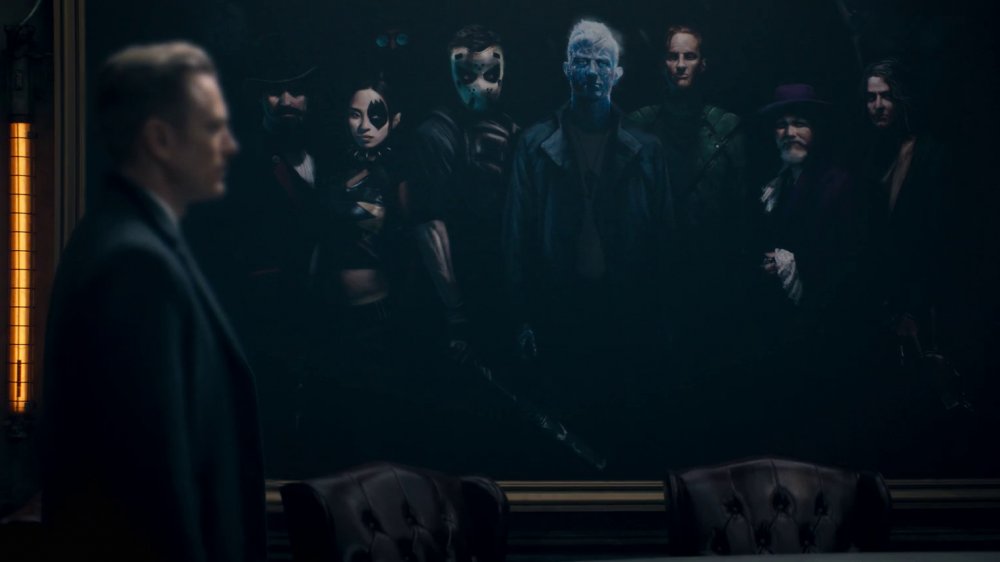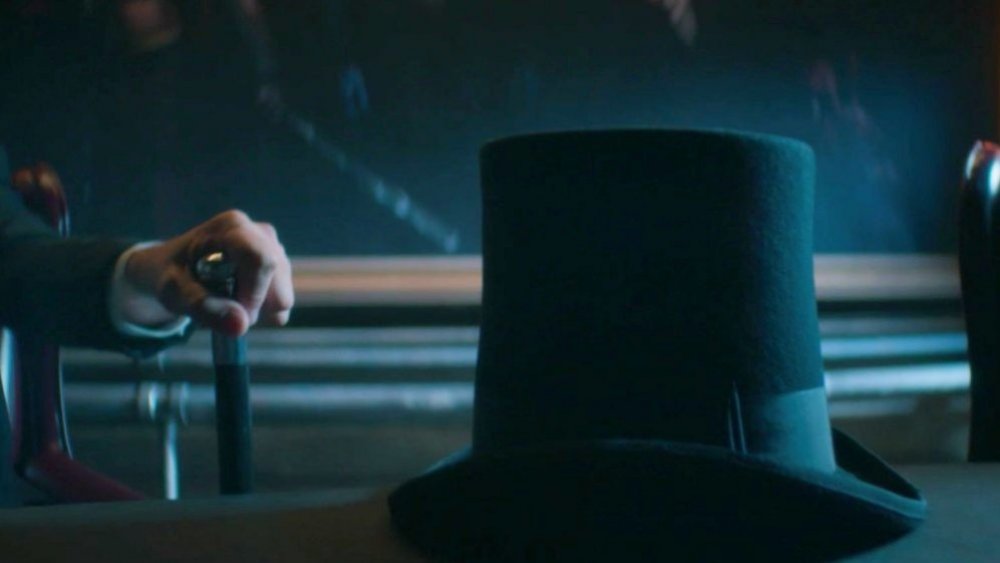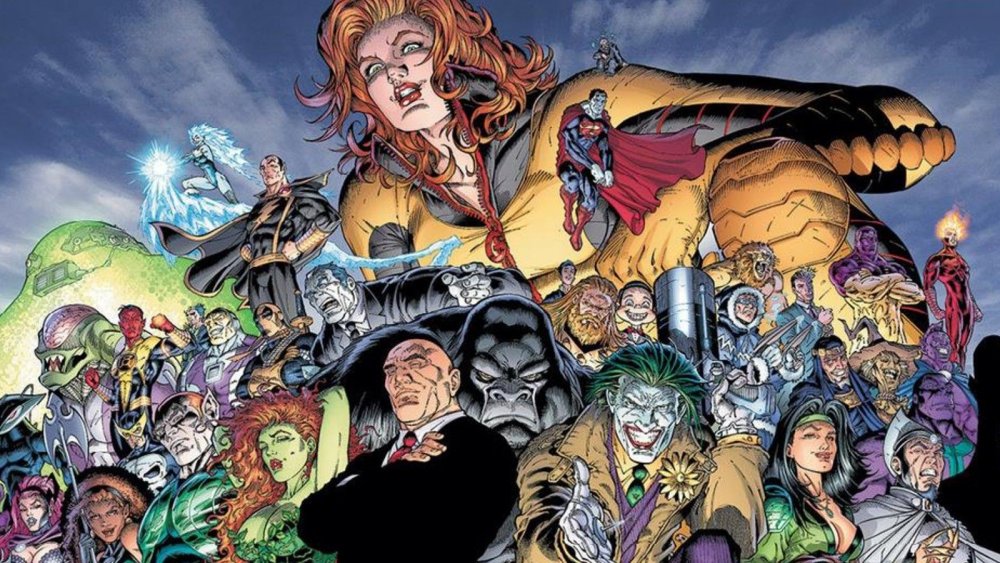The Untold Truth Of The Injustice Society
It may have taken until the first season of Stargirl to air in 2020 for the group to become more well-known, but the Injustice Society has been one of DC Comics' most formidable supervillain groups for decades. Counting sorcerers, assassins, ghosts, and monstrous powerhouses among their numbers, the Injustice Society has been working to put the Earth under its heel since before even the Justice League existed.
They've formed under slightly different names, different leadership, and with different team line-ups. Not to mention that — due to the nature of DC Comics' vast multiverse — they've shown up on different worlds. But the common denominator with every incarnation of the Injustice Society is that they're always working against either their heroic counterparts, the Justice Society of America (JSA), or the JSA's offshoots, like Infinity, Inc. No matter where or when they attack, you can bet it's the JSA who's in their crosshairs.
To learn more about this collection of bad guys that's been making trouble since the Golden Age of Comics, keep reading for the untold truth of the Injustice Society.
Meet the Injustice Society of the World
It's the villainous Wizard who brings together the very first incarnation of the Injustice Society of the World (ISW) in 1947's All-Star Comics #37. Wanting help to take down the JSA once and for all, Wizard recruits villains who — like him — have already either faced the JSA as a group or as individual members. The sorcerer brings aboard Per Degaton, the Thinker, the psychic Brainwave, Vandal Savage, and the Gambler.
However, the Injustice Society doesn't count solely on its members' physical abilities to get the job done. The bad guys organize mass jailbreaks from five different prisons and wrangle the escaping convicts under their control. With each individual member of the ISW boasting a small army under his command, they're able to split up and capture the different members of the JSA. For example, Vandal Savage captures Hawkman while the Gambler grabs the Atom. Brainwave comes back empty-handed, however, because he believes he unintentionally killed Green Lantern — a mistake the ISW pays for.
When the ISW puts the JSA on a mock trial with the Thinker as judge, the villains are shocked when Thinker ends the proceedings by declaring the JSA innocent. It turns out Green Lantern survived his battle with Brainwave and disguised himself as the Thinker to infiltrate the trial. He frees his JSA colleagues, and together, they make short work of the ISW.
The Injustice Society returned in the 1970s
The Justice Society took a break from crime-fighting for a couple of decades, at least as far as the comic book racks were concerned. After All-Star Comics #57 hit the stands, it wouldn't be until 1976 that the title was revived with All-Star Comics #58. The Injustice Society wasn't about to let their old rivals handle the '70s without some company, and they brought along a powerful new member or two.
In a story unfolding between 1976's All-Star Comics #63 and 1976's All-Star Comics #66, the Injustice Society returns to trouble the JSA, opening their assault with an attack on Hawkman and Wildcat. After the Fiddler uses his mesmerizing music to force Hawkman and Wildcat into fighting one another, the monstrous Solomon Grundy strikes. Thankfully, Superman and Power Girl intervene, but it isn't the end of the Injustice Society's plans. One of the ISW founders, Vandal Savage, lures part of the JSA into the past by unleashing an army of robots upon the kingdom of Camelot, forcing the Shining Knight to turn to the JSA for help.
While the rest of the JSA deals with Savage, that's when Icicle, Thinker, Brainwave, and the Wizard infiltrate the JSA headquarters where they take Wildcat and Hourman hostage. After the JSA returns from their trip through time, the Injustice Society escapes with their captives, challenging the JSA to a showdown in Alaska to save their friends. Predictably, the JSA meets the challenge and makes short work of the Injustice Society once more.
The bad guys reinvent themselves as Injustice, Unlimited
In 1984, younger spin-offs of JSA heroes — unable to secure spots in the Justice Society — form their own team and call it Infinity, Inc. Among other things, the new Infinity, Inc. title includes some of the earliest professional work you can find by Spawn creator Todd McFarlane, who contributed to the Injustice Society's reinvention as Injustice, Unlimited.
In 1987's Infinity, Inc. #34, Injustice, Unlimited appears as a kind of superpowered mafia. The line-up includes classic members like Wizard, Fiddler, and Per Degaton, along with a few new additions like Tigress and Hazard. Injustice, Unlimited's plan is to hold the world's richest corporations hostage for money that they need to "protect" those companies' assets. Their new philosophy extends to their dealings with superheroes. For example, after the villains capture Hourman and Icemaiden, they force Infinity, Inc. and the Global Guardians to do their bidding if they want to keep the kidnapped heroes alive, including helping the bad guys break Sportsmaster and Huntress out of prison.
Eventually the heroes — with the surprising help of Solomon Grundy — defeat Injustice, Unlimited, though they don't get through the ordeal without scars. In the final battle, an enraged Hourman kills Wizard, traumatizing the young hero. Later on, Injustice, Unlimited would reform under the leadership of the Dummy, but outside the pages of Infinity, Inc., this particular reinvention of the Injustice Society would never be heard from. The Wizard, on the other hand, would prove to be less dead than Hourman believed.
The Injustice Society of Johnny Sorrow
In the late 2000's JSA #9, a new bad guy adopts the name "Injustice Society" with a revamped line-up. The strange villain Johnny Sorrow recruits Count Vertigo, Killer Wasp, Blackbriar Thorn, Tigress, Icicle, and Geomancer to help him take down the JSA.
Eventually, readers would learn that unlike previous leaders of the Injustice Society, Johnny Sorrow was serving a very specific entity. Decades earlier, the former silent film actor's body was torn apart and transported to another dimension during an encounter with the JSA. In that other realm, Sorrow encountered the King of Tears — a powerful, evil being who sent Sorrow back to Earth with the understanding that Sorrow would make it possible for the King of Tears to materialize on our world. The King also gave Sorrow a mask, and if his face is ever uncovered, seeing it will prove fatal.
In spite of being a fairly ruthless villain, Sorrow's first Injustice Society doesn't prove very effective. When the group infiltrates the JSA's headquarters, they find Wildcat, who's able to defeat the bad guys all by himself. Sorrow's second try is somewhat more successful. The villain buffs up the group with the Thinker A.I., Shiv, Rival, and longtime Shazam antagonist Black Adam. Sorrow succeeds in summoning the King of Tears ... only for the Flash to send both the King and Sorrow to another dimension. Sorrow's time as Injustice Society leader ends with him exiled, Black Adam changing sides, and Blackbriar Thorn and Rival dead.
The return of the Wizard
In the first issue of the miniseries JSA: All-Stars, the Injustice Society returns for arguably their most unique appearance. On one hand, the villains' job is relatively limited, and they're successful at it, making it possibly the first time the Injustice Society actually accomplishes its goal. On the other, the bad guys have a brand new leader, who turns out to be not very new at all.
The Injustice Society attacks in 2003's JSA: All-Stars #1, and as usual, they make challenging foes for the JSA but not quite challenging enough to worry the heroes too much. It turns out, however, that the Injustice Society isn't there to kill the JSA. Instead, they've only been tasked with attaching discs to the bodies of the older JSA members which, in turn, teleport the heroes away from the battlefield. The older heroes wind up in the care of the Injustice Society's new leader, a demon going by the name Legacy.
But in the end, Legacy proves to be an old dog trying a new trick. In JSA: All-Stars #8, Legacy is revealed to be the Injustice Society founder Wizard. Once Wizard is unveiled, the Spectre kills him with a single gesture in spite of the JSA's protests.
The Injustice Guild seems kinda familiar
We meet an interesting echo of the Injustice Society in a 2002 two-part episode of the Justice League animated series. In "Legends," four members of the Justice League are unintentionally transported to a parallel Earth. There, they encounter the Justice Guild of America — an obvious echo of the JSA. The Justice Guild acts in the same goofy, cornball ways readers of Golden Age comics would be used to, like allowing the young mascot Ray to accompany them on dangerous adventures and calling for cookies and milk after a day fighting crime.
Predictably, the Justice Guild is countered by the Injustice Guild, whose members are altered versions of classic Injustice Society members. Instead of Sportsmaster, there's Sportsman. Instead of Wizard, there's the turban-wearing Sir Swami. Dr. Blizzard replaces Icicle, and Music Master fights heroes with an accordion as opposed to the Fiddler and his violin. The Justice League and Justice Guild join forces to take down the bad guys, though they soon learn the Injustice Guild aren't the ones they really have to worry about.
Green Lantern and Hawkgirl discover the world they're on is an illusion. After the real Justice Guild died trying and failing to prevent a nuclear apocalypse, Ray was mutated and given psychic powers that allowed him to create and maintain the vast illusion of Seaboard City and its heroes. Presumably, the villains of the Injustice Guild used to exist before the nuclear war that ravaged it just as the Justice Guild did, though it's never confirmed.
The Injustice Society of Stargirl features some pretty evil supervillains
The first season of Stargirl premiered in 2020 with a scene that proves the series' version of the Injustice Society — now the Injustice Society of America (ISA) — is the most dangerous we've ever seen. The first episode opens with a flashback of the Injustice Society killing almost everyone in the JSA. The only heroes who appear to survive are Stripesy (Luke Wilson) and Hourman (Lou Ferrigno Jr.). Stripesy lives on to become S.T.R.I.P.E., and he helps to form the new JSA, though a few years later, Hourman and his wife are murdered by Solomon Grundy.
As ruthless as they are, this version of the Injustice Society is different in that their unforgivable means work towards laudable goals. Under the leadership of Icicle (Neil Jackson) and the Dragon King (Nelson Lee), the ISA's "Project: New America" means to boost the psychic powers of Brainwave (Christopher James Baker) in order to change the minds of everyone in Nebraska and many of the surrounding states to the ISA's way of thinking. While the ISA believes in noble things like equality for underrepresented people, Brainwave's psychic assault will kill approximately 25% of the people exposed to it.
Thankfully, the first season of Stargirl ends with the ISA's plans foiled and many of its members killed. Icicle, Brainwave, and Dragon King all die in the season 1 finale, and Wizard (Joe Knezevich) and Fiddler (Hina X. Khan) are both murdered earlier in the season.
The future of Stargirl's Injustice Society
While the ISA is defeated in the season 1 finale of Stargirl and its ranks are thinned considerably, it's clear they're not down for the count. One of the more anticipated reveals comes towards the end of the episode, with the Shade finally showing up alone at the ISA's conference table. While he doesn't appear for most of the first season, we see Shade's powers kill Dr. Mid-Nite (Henry Thomas) in the series premiere, and his depiction is just barely visible in the portrait of the ISA above the group's conference table. Speaking presumably to himself, the Shade says he always knew Icicle's plan would never work, and his presence in the ISA's headquarters implies he means to be the group's next leader.
Meanwhile, we see Dragon King's daughter, Shiv (Meg DeLacy), seek out a powerful ally. In a storage room, the young villain tears through boxes, eventually finding a jewel in which the spirit of the powerful villain Eclipso is imprisoned. Time will tell if Shiv and her new ally will join the Shade in his future endeavors.
At the same time, in spite of their losses, the ISA still has plenty of living members. Though defeated, Gambler (Eric Goins), Sportsmaster (Neil Hopkins), and Tigress (Joy Osmanski) survive the season finale. At the same time, children of fallen ISA members like Icicle and Fiddler are still around who may — like their comic book counterparts — choose to take up the dark legacies of their parents.
There's a lot of injustice going around
The word "justice" is used quite a bit in DC comics. Along with the Justice Society, there's the Justice League and its many variations (Justice League of America, Justice League International, etc.), and then there's also Young Justice. Since every coin needs two sides, "injustice" also gets quite a bit of use, and so the Injustice Society has the potential to get confused with the Injustice Gang and the Injustice League.
The main difference between the Injustice Society and these other groups is who they fight. While the Injustice Society almost always forms to lock horns with the JSA, the Injustice Gang and Injustice League do battle with the Justice League. Lex Luthor is often found at the head of both the Gang and the League, though not always.
Luthor, in fact, is nowhere to be found when the Injustice Gang first appears in 1974's Justice League of America #111, though he's there to create a new gang in 1997's JLA #10 that includes Joker, Circe, Doctor Light, Jemm, Ocean Master, and Mirror Master. His animated counterpart would use the name Injustice Gang again in the TV series Justice League. And while it's the powerful alien Agamemno who initially forms the Injustice League, it's Lex who leads the team in the late '80s Justice League International comics and mid-aughts issues of Justice League of America.
